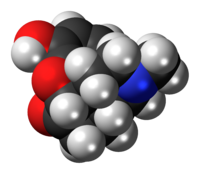Hydromorphone
 |
|
 |
|
| Clinical data | |
|---|---|
| Trade names | Dilaudid, Hydromorph Contin |
| AHFS/Drugs.com | Monograph |
| MedlinePlus | a682013 |
| Pregnancy category |
|
| Dependence liability |
Very High |
| Routes of administration |
oral, intramuscular, intravenous, subcutaneous, intranasal, rectal, sublingual, transmucosal, buccal, transdermal (experimental) |
| ATC code | |
| Legal status | |
| Legal status |
|
| Pharmacokinetic data | |
| Bioavailability | Oral: 30–35%, Intranasal: 52–58% IV/IM:100% |
| Protein binding | 20% |
| Metabolism | Hepatic |
| Biological half-life | 2–3 hours |
| Excretion | Renal |
| Identifiers | |
|
|
| Synonyms | dihydromorphinone |
| CAS Number | |
| PubChem CID | |
| IUPHAR/BPS | |
| DrugBank | |
| ChemSpider | |
| UNII | |
| KEGG | |
| ChEBI | |
| ChEMBL | |
| ECHA InfoCard | 100.006.713 |
| Chemical and physical data | |
| Formula | C17H19NO3 |
| Molar mass | 285.3g/mol |
| 3D model (Jmol) | |
| Solubility in water | HCl: 333 mg/mL (20 °C) |
|
|
|
|
Hydromorphone, also known as dihydromorphinone, and sold under the brand names Dilaudid among others, is a centrally acting pain medication of the opioid class. It is a derivative of morphine; to be specific, it is a hydrogenated ketone thereof. Comparatively, hydromorphone is to morphine as hydrocodone is to codeine—that is, a semi-synthetic drug. In medical terms, it is an opioid analgesic and, in legal terms, a narcotic. Hydromorphone is commonly used in the hospital setting, mostly intravenously (IV) because its bioavailability is very low orally, rectally, and intranasally. Sublingual administration (under the tongue) is usually superior to swallowing for bioavailability and effects; however, hydromorphone is bitter and hydrophilic like most opiates, not lipophilic, so it is absorbed poorly and slowly through mouth membranes.
Hydromorphone is much more soluble in water than morphine and, therefore, hydromorphone solutions can be produced to deliver the drug in a smaller volume of water. The hydrochloride salt is soluble in three parts of water, whereas a gram of morphine hydrochloride dissolves in 16 ml of water; for all common purposes, the pure powder for hospital use can be used to produce solutions of virtually arbitrary concentration. When the powder has appeared on the street, this very small volume of powder needed for a dose means that overdoses are likely for those who mistake it for heroin or other powdered narcotics, especially those that have been cut or 'stepped on' already.
Very small quantities of hydromorphone are detected in assays of opium on rare occasions; it appears to be produced by the plant under circumstances and by processes which are not understood at this time and may include the action of bacteria. A similar process or other metabolic processes in the plant may very well be responsible for the very low quantities of hydrocodone also found on rare occasions in opium and alkaloid mixtures derived from opium. Dihydrocodeine, oxymorphol, oxycodone, oxymorphone, metopon, and possibly other derivatives of morphine and hydromorphone also are found in trace amounts in opium.
...
Wikipedia
